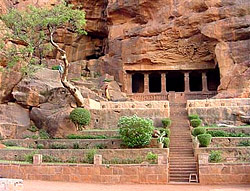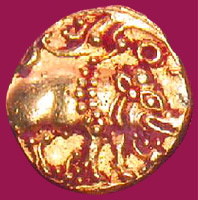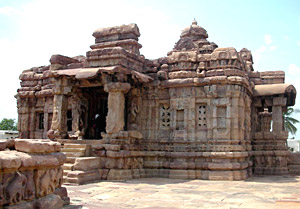 In the 6th century, with the decline of the Gupta dynasty and their immediate descendants in northern India, foremost changes were undertaken in the southern area of the Vindyas- the Deccan and Tamilaham. The age of small kingdoms had given way to large empires in this region. Pulakesi I in 550 established the Chalukya dynasty. Pulakesi I took Vatapi (Badami in Bagalkot district, Karnataka) under his control and made it his capital. Pulakesi I and his descendants, are referred to as Chalukyas of Badami. They ruled over an empire that comprised the entire state of Karnataka and most of Andhra Pradesh in the Deccan. Pulakesi II whose precoronation name was Ereya was perhaps the greatest emperor of the Badami Chalukyas.
In the 6th century, with the decline of the Gupta dynasty and their immediate descendants in northern India, foremost changes were undertaken in the southern area of the Vindyas- the Deccan and Tamilaham. The age of small kingdoms had given way to large empires in this region. Pulakesi I in 550 established the Chalukya dynasty. Pulakesi I took Vatapi (Badami in Bagalkot district, Karnataka) under his control and made it his capital. Pulakesi I and his descendants, are referred to as Chalukyas of Badami. They ruled over an empire that comprised the entire state of Karnataka and most of Andhra Pradesh in the Deccan. Pulakesi II whose precoronation name was Ereya was perhaps the greatest emperor of the Badami Chalukyas.
Also acknowledged as Immadi Pulakesi, he is considered one of the great kings in Indian history. His queen Kadamba Devi, was a princess from the dynasty of Alupas. They maintained close family and marital relationship with the Alupas of South Canara and the Gangas of Talakad. Pulakesi II extended the Chalukya Empire up to the northern extents of the Pallava kingdom and halted the southward march of Harsha by defeating him on the banks of the river Narmada. He then defeated the Vishnukundins in the southeastern Deccan. Pallava Narasimhavarman however reversed this victory by attacking and occupying the Chalukya capital Vatapi (Badami) temporarily.
The Badami Chalukya dynasty went in to a brief decline following the death of Pulakesi II due to internal feuds. It recovered during the reign of Vikramaditya I, who succeeded in pushing the Pallavas out of Badami and restoring order to the empire. The empire reached a peak during the rule of the illustrious Vikramaditya II who defeated the Pallava Nandivarman II and captured Kanchipuram. The last Badami Chalukya king Kirtivarman I was overthrown by the Rashtrakuta Dantidurga in 753. At their peak they ruled a vast empire stretching from the Kaveri to the Narmada.
Government
 Army: The army comprised of infantry, cavalry, elephant unit and a dominant navy. The Chinese traveler Hiuen-Tsiang refers that the Chalukya army consisted of hundreds of elephants, which were inebriated with liquor prior to battle. Their navy subjugated Revatidvipa (Goa) and Puri on east coast of India. Rashtrakuta inscriptions use the idiom Karnatabala referring to their commanding armies. Taxes were levied and called Herjunka, Kirukula, Bilkode and Pannaya.
Army: The army comprised of infantry, cavalry, elephant unit and a dominant navy. The Chinese traveler Hiuen-Tsiang refers that the Chalukya army consisted of hundreds of elephants, which were inebriated with liquor prior to battle. Their navy subjugated Revatidvipa (Goa) and Puri on east coast of India. Rashtrakuta inscriptions use the idiom Karnatabala referring to their commanding armies. Taxes were levied and called Herjunka, Kirukula, Bilkode and Pannaya.
Land Governance: The empire was alienated into Maharashtrakas (provinces), then into minor Rashtrakas (Mandala), Vishaya (district), Bhoga (group of 10 villages), analogous to the Dasagrama unit used by the Kadambas. At the subordinate levels of organization, the Kadamba style entirely reigned. The Sanjan plates of Vikramaditya I even mention a land unit termed Dasagrama. There were many autonomous regions ruled by feudatories like Alupas, Gangas, Banas, Sendrakas etc. Local assemblies worked on the local issues. Groups of mahajanas (learned brahmins) looked after agraharas (like Ghatika or place of higher learning) like the ones at Badami (2000 mahajans) and Aihole (500 mahajanas).
Coinage: The Badami Chalukyas imprinted coins of an unusual standard in contrast to the northern realms. The coins comprised of Nagari and Kannada legends. They minted coins with cryptograms of temples, lion or boar facing right and the lotus. The coins weighed 4 grams and were called honnu in old Kannada and had fractions such as fana and the quarter fana, whose contemporary equivalent being hana (literally means, money). A gold coin called Gadyana is mentioned in some record in Pattadakal that later came to be known a varaha which was also witnessed on their emblem.
Religion: The rule of the Badami Chalukya was a period of religious concord. Initially they followed Vedic Hindusim, as observed in the diverse shrines devoted to countless popular Hindu deities with Aihole as the experimental laboratory. Pattadakal is the location of their grandest architecture. The worship of Lajja Gauri, the fertility goddess was equally popular. Later from the era of Vikramaditya I an inclination towards Shaivism and sects like Pashupata, Kapalikas and Kalamukhas subsisted. However, they enthusiastically encouraged Jainsm and confirmed to by one of the Badami cave temples and other Jain temples in the Aihole complex. Ravikirti, the court poet of Pulakesi II was a Jain. Buddhism was on a decline having made its ingress into Southeast Asia, as confirmed by Hiuen-Tsiang. Badami, Aihole and Kurtukoti, Puligere (Laksmeshwara in Gadag district) were primary places of learning.
 Art and Architecture: The primarily long-term inheritance of the Chalukya dynasty is the architecture and art they left behind. More than one hundred and fifty monuments attributed to the Badami Chalukya, and built between 450 and 700, remain in the Malaprabha basin in Karnataka.
Art and Architecture: The primarily long-term inheritance of the Chalukya dynasty is the architecture and art they left behind. More than one hundred and fifty monuments attributed to the Badami Chalukya, and built between 450 and 700, remain in the Malaprabha basin in Karnataka.
The rock-cut temples of Pattadakal, a UNESCO World Heritage Site, Badami and Aihole are their most celebrated monuments. Two of the famous paintings at Ajanta cave no. 1, "The Temptation of the Buddha" and "The Persian Embassy" is attributed to them. This is the commencement of Chalukya style of architecture and a consolidation of South Indian style.
In Aihole, the Durga temple (6th century), Ladh Khan temple (450), Meguti temple (634), Hucchimalli and Huccappayya temples (5th century), Badami Cave Temples (600) are examples of early Chalukyan art. The splendid temples at Pattadakal were commissioned by Vikramaditya II (740). Here the Virupakshaand Mallikarjuna (740), Sangameswara (725) and a Jain temple are in the Dravidian style while Jambulinga, Kasivisweswara and Galaganatha (740) are in the Northern nagara style. The Papanatha (680) temple shows an attempt to combine the Northern and Southern styles.
According to certain art reviewers, the Badami Chalukya style is a "prayaga" or meeting of formal trends of architecture, the dravida and nagara. The temples were a result of religious zeal and intensity of reason.
Society: The Hindu caste system was prevalent and the administration recognized prostitution. Some kings preserved concubines (Ganikas) who were given much respect; sati was perhaps absent as widows like Vinayavathi and Vijayanka are mentioned in account. Devadasis` were present in temples. Sage Bharata`s Natyashastra the precursor to Bharatanatyam, the dance of South India was popular as seen in many sculptures and mentioned in inscriptions. Women benefit from political power in administration. Queens Vijayanka, a renowned Sanskrit poetess, Kumkumadevi, the younger sister of Vijayaditya and Lokamahadevi, queen of Vikramaditya II who fought wars position as examples.



















